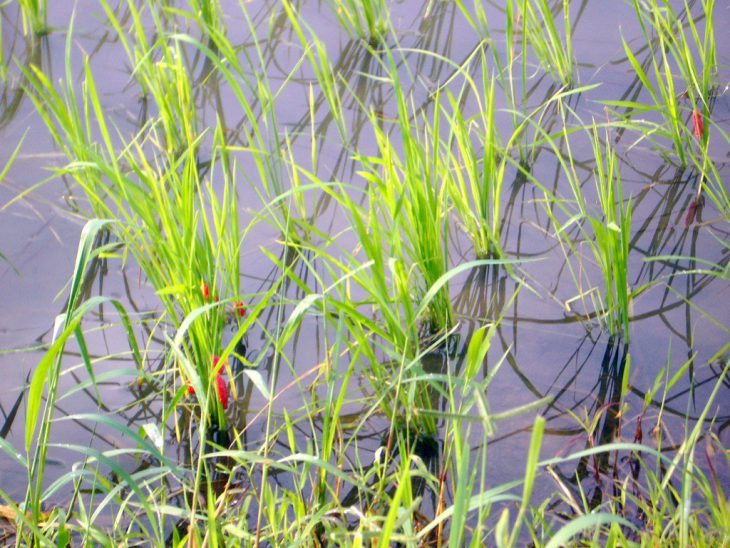With the world’s population growing, it is critical that we develop better ways of producing food and preserving our natural resources. Researchers around the world continue to update our agricultural practices to preserve freshwater, increase crop production, and reduce the production of harmful gasses. One important crop of interest is rice.
If you have ever driven by a large rice field, you likely would have seen many tall plants in a flooded paddy. There are over 160 million hectares of flooded rice paddies around the world, which is traditionally the best way to grow rice. Flooding prevents weeds from invading rice fields as their roots suffocate under water. On the other hand, rice and other wetland plants can survive in oxygen-poor (anaerobic) soils due to spongy tubes called aerenchyma that allow for the transport of oxygen from the leaves down to the roots.
However, rice paddies use a lot of freshwater, which is a problem during droughts. Additionally, microbes in the anaerobic rice fields produce carbon dioxide, nitrous oxide, and 8% of the world’s methane. All of these gasses are known to contribute to climate change.
To address these issues, a team of scientists from the Netherlands and Italy set out to study an alternate wetting and drying irrigation practice. This method has been shown in previous studies to both preserve water and increase the amount of oxygen in the fields. As a result, it seems to produce greater yields of rice that are richer in nutrients than the traditional flooding method. Yield and nutrient density can sometimes be affected by the type of microbes living in the paddies, so the team set out to test if this was indeed the case here.
The team set up 4 fields for the traditional flooding method and 4 fields for the alternating method. Each field had 12 different plots seeded with European rice species. Once the seeds began to grow, all plots were flooded with a few inches of water until the plants reached the three-leaves stage. At this point, the alternate wetting and drying plots were allowed to naturally dry out until they reached a water pressure of -30 kPa (the pressure at about 25 centimeters, or 10 inches) before being re-flooded and left to dry out again.
Just before the flowering stage, the scientists collected soil samples from the roots of rice plants and from the soil further out in the fields, called bulk soil, to collect bacterial DNA. They “fingerprinted” the microbes in the samples by comparing differences in a gene called the 16S rRNA gene, which codes for a universal part of the cell.
From the 24 rice plant roots and bulk soil samples, the scientists were able to identify nearly 23,000 types of microbes. By comparing the different microbe groups in the bulk soil and in the root soil, it was found that the bulk soil was more diverse. This was unsurprising as plants often create environments for a select few partner microbes to grow in.
However, when comparing the soils of flooding and alternating fields, there were several key differences. While drying had little effect on how many different microbes were present in the root soil, there was a change in which microbes were present. Drying out the soils introduced oxygen, increasing the amount of oxygen-loving microbes known for promoting plant growth. The increase in oxygen decreased the amount of anaerobic microbes that are often major producers of greenhouse gasses.
Interestingly, the number of different microbes in the bulk soil did not change between flooding or alternating irrigation methods. The scientists suspect that the bulk soil microbes are used to the seasonal changes in moisture. Farmers will often flood their fields during the growing season and then let their fields dry out in the off season. After centuries of these seasonal changes, the farmers have selected for microbes that are adapted to resist long periods of drought. Because the root microbes were more sensitive to changes in irrigation methods, the scientists hypothesize that these microbes may be the key to healthier, more nutritious rice.
With the findings of this study, future work can be done to address the growing human population and better adapt our agricultural practices to the challenges of today and tomorrow.


